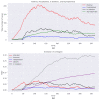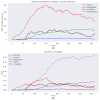An Agent-Based Model of the Local Spread of SARS-CoV-2: Modeling Study
- PMID: 33750735
- PMCID: PMC8025915
- DOI: 10.2196/24192
An Agent-Based Model of the Local Spread of SARS-CoV-2: Modeling Study
Abstract
Background: The spread of SARS-CoV-2, originating in Wuhan, China, was classified as a pandemic by the World Health Organization on March 11, 2020. The governments of affected countries have implemented various measures to limit the spread of the virus. The starting point of this paper is the different government approaches, in terms of promulgating new legislative regulations to limit the virus diffusion and to contain negative effects on the populations.
Objective: This paper aims to study how the spread of SARS-CoV-2 is linked to government policies and to analyze how different policies have produced different results on public health.
Methods: Considering the official data provided by 4 countries (Italy, Germany, Sweden, and Brazil) and from the measures implemented by each government, we built an agent-based model to study the effects that these measures will have over time on different variables such as the total number of COVID-19 cases, intensive care unit (ICU) bed occupancy rates, and recovery and case-fatality rates. The model we implemented provides the possibility of modifying some starting variables, and it was thus possible to study the effects that some policies (eg, keeping the national borders closed or increasing the ICU beds) would have had on the spread of the infection.
Results: The 4 considered countries have adopted different containment measures for COVID-19, and the forecasts provided by the model for the considered variables have given different results. Italy and Germany seem to be able to limit the spread of the infection and any eventual second wave, while Sweden and Brazil do not seem to have the situation under control. This situation is also reflected in the forecasts of pressure on the National Health Services, which see Sweden and Brazil with a high occupancy rate of ICU beds in the coming months, with a consequent high number of deaths.
Conclusions: In line with what we expected, the obtained results showed that the countries that have taken restrictive measures in terms of limiting the population mobility have managed more successfully than others to contain the spread of COVID-19. Moreover, the model demonstrated that herd immunity cannot be reached even in countries that have relied on a strategy without strict containment measures.
Keywords: COVID-19; SARS-CoV-2; agent; agent-based modeling; computation; computational epidemiology; computational models; epidemiology; modeling; policy; public health; spread.
©Alessio Staffini, Akiko Kishi Svensson, Ung-Il Chung, Thomas Svensson. Originally published in JMIR Medical Informatics (http://medinform.jmir.org), 06.04.2021.
Conflict of interest statement
Conflicts of Interest: None declared.
Figures









References
-
- Silverman E, Gostoli U, Picascia S, Almagor J, McCann M, Shaw R, Angione C. Situating agent-based modelling in population health research. arXiv. 2021 Preprint posted online on February 6, 2020 https://arxiv.org/abs/2002.02345. - PMC - PubMed
-
- Bomblies A. Agent-based modeling of malaria vectors: the importance of spatial simulation. Parasit Vectors. 2014 Jul 03;7:308. doi: 10.1186/1756-3305-7-308. https://parasitesandvectors.biomedcentral.com/articles/10.1186/1756-3305... - DOI - DOI - PMC - PubMed
LinkOut - more resources
Full Text Sources
Miscellaneous

